For cat lovers, there are many joys of feline companionship, but so are the challenges—especially when it comes to keeping a clean and hygienic home. One of the persistent challenges encountered by individuals who own cats is the problem of litter tracking. This phenomenon occurs when tiny granules of litter cling to your cat's paws and fur, only to be scattered throughout your home as they roam. Not only can this leave your floors feeling gritty and your surfaces dusted with litter, but it also raises concerns about cleanliness and hygiene.
Litter tracking can turn what should be a confined and manageable part of cat care into a widespread household nuisance. From stepping on stray litter granules with bare feet to finding them in places far removed from the litter box, the impact on your home's cleanliness can be significant. Moreover, this issue touches on more than just the annoyance of constant clean-up; it also involves the spread of bacteria and potential allergens, making it a matter of health as well as comfort.
In this blog post, we'll share a few practical solutions and innovative strategies to minimize tracking, ensuring your home remains as clean and comfortable as possible without compromising the well-being and freedom of your beloved pet.
How To Stop Cat Litter From Tracking
Choose the Right Litter
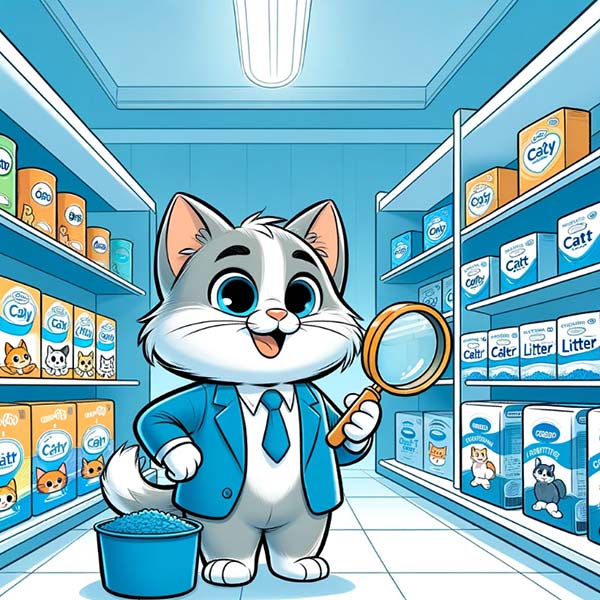
Keeping your home clean and minimizing cat litter tracking starts with the crucial choice of the right type of litter. The variety of litter available on the market varies widely in terms of texture, size, and material, each with its own propensity for sticking to your cat's paws and being tracked throughout your house.
For example, while finer, sand-like litters may be more comfortable for cats, they tend to stick to their paws more easily, leading to greater tracking. In contrast, pellet-style litters or those made from specific materials may not adhere as much to your cat's paws, thus reducing tracking.
The debate between clumping and non-clumping litters also plays a role in this issue. Like traditional clay litter, clumping litter is known for its ease of waste removal and odor control and can sometimes contribute to tracking if not properly managed. Non-clumping litter, though perhaps a bit less convenient for cleaning, might offer an advantage by being less likely to be tracked. Ultimately, the extent of litter tracking will vary depending on factors such as the type of litter used and its weight.
Fortunately, the pet care market has recognized the issue of litter tracking and has responded with a variety of low-tracking litter options. These products are specifically designed with larger, more cohesive particles that are less likely to stick to your cat's paws or get caught in their fur. Additionally, some litters are formulated to create less dust, contributing to a cleaner home and supporting a healthier environment for both you and your cat by reducing airborne particles.
Litter Box Modifications
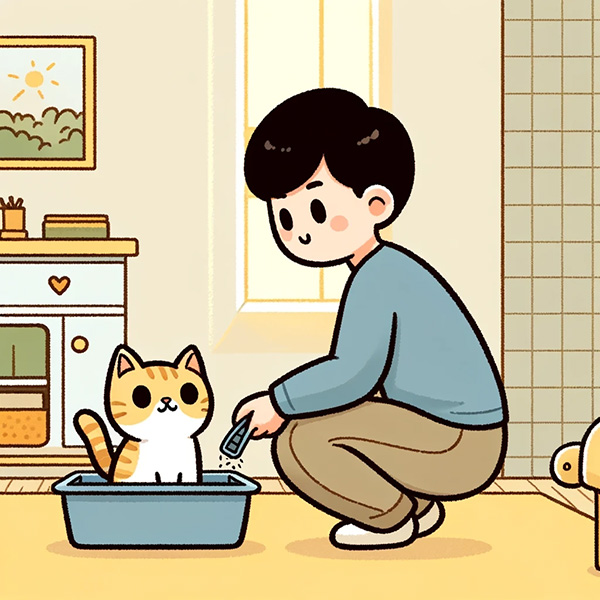
Addressing the challenge of cat litter tracking extends beyond just selecting the right type of litter; it also involves considering the design and modifications of the litter box itself. Litter box modifications play a crucial role in minimizing the spread of litter and keeping your home clean.
Among the most effective solutions to combat litter tracking are high-sided, top-entry litter boxes and covered litter boxes. These designs are ingeniously crafted to contain litter within the box, significantly reducing the amount of litter that gets kicked out during use or sticks to your cat's paws as they exit.
High-sided litter boxes offer tall walls to prevent litter from being scattered outside the box by cats who energetically dig or cover their waste. Meanwhile, a top-entry litter box takes this concept a step further by limiting access to the litter area from the top, which not only helps contain the litter but also encourages cats to shake off excess litter from their paws on the lid before jumping down. This design inherently reduces the amount of litter that gets tracked onto your floors, as it captures much of the litter from your cat's paws upon exit.
Enclosed litter boxes can play a crucial role in reducing the spread of cat litter throughout your home. By enclosing the litter area, a covered box effectively contains litter within its confines, significantly reducing the amount of litter kicked out during your cat's digging and covering activities. This containment helps prevent litter particles from spreading onto the floor around the box, reducing the likelihood of those particles being tracked further into your living spaces. Additionally, the design of a covered litter box can encourage cats to shake off excess litter from their paws inside the box as they exit, further diminishing the amount of litter tracked.
By implementing these litter box modifications, cat owners can significantly lessen the prevalence of litter tracking, leading to a cleaner and more hygienic home environment. This approach demonstrates how a thoughtful consideration of litter box design can have a profound impact on reducing litter scatter and enhancing the cleanliness of your living space.
Use Anti-Tracking Litter Mat
An often overlooked yet incredibly effective strategy for minimizing cat litter tracking throughout your home is the use of anti-tracking litter mats. Placing an anti-tracking mat directly in front of the litter box is a simple yet ingenious solution to catch and contain litter particles clinging to the paws. These specially designed mats feature textures and materials that gently dislodge litter from the paws as they step out of the box, trapping it within the mat's fibers or grooves. This not only prevents litter from being spread across your floors but also significantly reduces the amount of cleaning required to maintain a tidy and hygienic home.
Anti-tracking litter mats are available in various sizes, materials, and textures, giving you the flexibility to select one that aligns with your cat's preferences and complements the aesthetic of your home. Incorporating an anti-tracking litter mat into your litter box setup creates an effective barrier that tackles litter tracking right at the source. This straightforward addition to your cat care regimen can profoundly impact keeping your living spaces clean, demonstrating how a small change can significantly combat the challenge of litter scatter and maintain a cleaner, more pleasant home environment.
Litter Box Placement
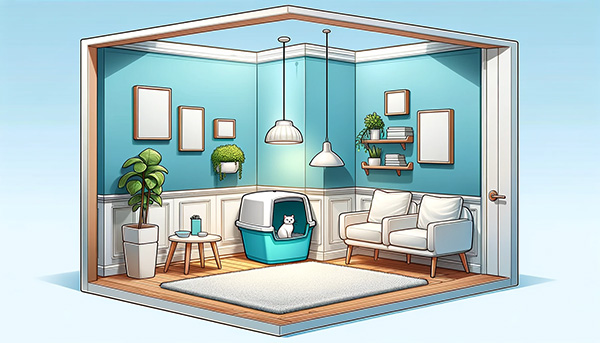
The strategic placement of the litter box within your home can play a crucial role in mitigating the issue of cat litter tracking, an often overlooked yet significant factor in maintaining cleanliness and hygiene. By carefully considering where to position the litter box, you can effectively contain any potential tracking to less trafficked or isolated areas, minimizing the spread of litter throughout your home.
Placing the litter box in a location that is accessible to your cat but away from high-traffic zones ensures that any litter particles that do escape or cling to your cat's paws are less likely to be distributed across your living spaces.
Additionally, selecting a somewhat secluded spot can provide your cat privacy while keeping any litter scattered and confined to an area that is easier to clean and maintain. For example, laundry rooms, bathrooms, or a quiet corner in a spare room can be ideal locations for a litter box. These areas typically see less foot traffic, which helps keep the rest of your home cleaner and reduces the disturbance to your cat's routine.
Daily Cleanup
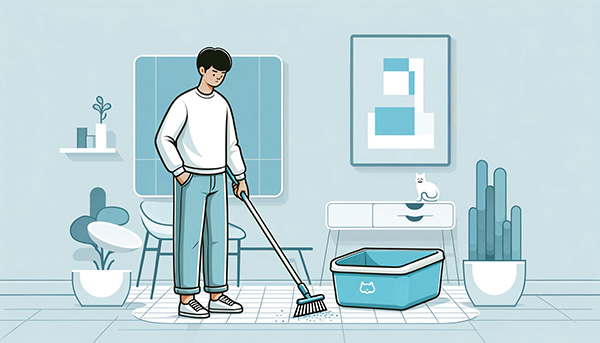
Incorporating daily cleanup routines around your cat's litter box is a pivotal strategy in the ongoing battle to stop litter from tracking throughout your home. Regular cleaning plays a crucial role in minimizing the spread of litter, as it directly addresses any particles that escape the box before they can be distributed further by foot traffic—whether feline or human. Tools such as a hand broom and dustpan positioned near the litter box for quick sweeps, or even a robotic vacuum set to run at certain times, can significantly ease the task of maintaining a clean area around the litter station.
By promptly removing litter particles from around the box each day, you not only prevent them from being tracked into other areas of your home but also contribute to a more hygienic environment. This daily attention to cleanliness around the litter box area discourages the accumulation of excess litter on your cat's paws, thereby reducing the likelihood of tracking. Furthermore, maintaining a routine of frequent litter box cleaning ensures the box remains an appealing and comfortable spot for your cat, promoting consistent use and preventing behavioral issues that can arise from a dirty litter box.
Use Litter Box Furniture
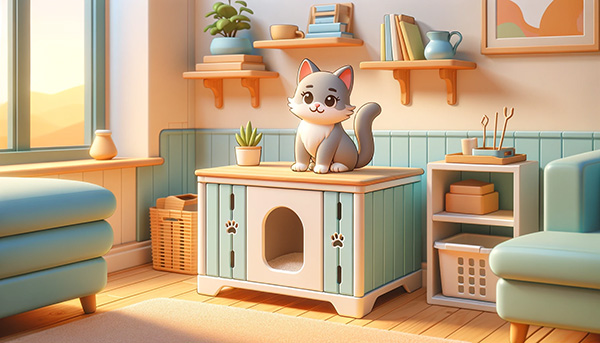
Using litter box furniture is an innovative and stylish solution to minimize cat litter tracking in your home. These pieces are designed to conceal the litter box, blend seamlessly with your home decor, and tackle the tracking issue head-on. Many litter box furniture options include built-in tracking mats or textured surfaces within the enclosure, which help to catch and contain litter particles from your cat's paws as they exit. This dual functionality enhances the aesthetic appeal of your space and significantly reduces the spread of litter, keeping your floors cleaner. Putting your litter box inside furniture creates a discrete and effective litter management system, contributing to a tidier and more hygienic home environment.
